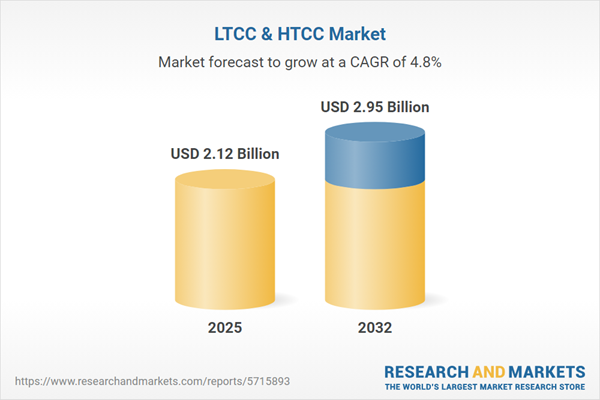Speak directly to the analyst to clarify any post sales queries you may have.
The LTCC & HTCC ceramic substrate market is enabling advanced electronics manufacturing by supporting device miniaturization, efficient thermal management, and elevated component reliability. Senior decision-makers are focusing on these specialized substrates to accelerate innovation and strengthen organizational competitiveness.
Market Snapshot: LTCC & HTCC Ceramic Substrate Market
The global LTCC (low temperature co-fired ceramic) and HTCC (high temperature co-fired ceramic) substrate market is displaying consistent growth in terms of both overall revenue and compound annual growth rate (CAGR). This momentum is propelled by greater demand for compact, high-performance electronic components across varied industries. Organizations recognize LTCC & HTCC substrates as fundamental to integrating multiple device functions and adding adaptability within electronic packaging. For decision-makers, key focus areas in this evolving market include advancing manufacturing processes, forecasting technical enhancement, and ensuring stable operations in the face of ongoing innovation.
Scope & Segmentation of the LTCC & HTCC Market
- Product Types: HTCC substrates, primarily composed of alumina and mullite, offer significant mechanical strength for high-stress electronic environments. LTCC substrates utilize glass and crystalline ceramics, making them suitable for miniaturized devices demanding compactness and precision assembly.
- Manufacturing Processes: Use of tape casting, lamination, screen printing, and precision punching enables flexible product design and optimized quality across diverse applications, supporting dynamic supply networks.
- End Use Industries: Key sectors include automotive (notably electric vehicle system integration), telecommunications, medical instruments, consumer electronics, aerospace, and defense. Ceramic substrates in these fields ensure long-term reliability where consistent performance is critical.
- Applications: HTCC performs reliably under ongoing mechanical and thermal loads, aligning with requirements in aerospace, advanced medical devices, and defense. LTCC is essential for space-efficient MEMS devices, RF and microwave modules, and sensor assemblies requiring tight spatial tolerances.
- Regional Coverage: Market adoption varies across the Americas, Europe, Middle East & Africa, and Asia-Pacific, each shaped by distinct compliance guidelines and sourcing preferences, which impact local supply chain strategies and competitive behavior.
- Company Coverage: Primary industry players include Kyocera Corporation, Murata Manufacturing, TDK Corporation, Hitachi Ltd., Yokowo Co., KOA Corporation, Maruwa Co., Taiyo Yuden, and Nippon Chemi-Con, along with specialized regional firms tailoring approaches to meet sector-specific needs.
Key Takeaways for Senior Decision-Makers
- Advanced ceramic substrates are integral for facilitating the miniaturization and digital transformation of automotive, healthcare, and telecommunications products.
- HTCC material solutions sustain performance under challenging conditions, benefiting operations in industries with stringent safety and reliability demands.
- LTCC substrates play a pivotal role in the advancement of compact diagnostic tools and sensing platforms, progressing technology within medical and industrial segments.
- Executives must respond strategically to evolving regional sourcing and complex regulatory expectations, emphasizing agile supply chain management and operational compliance.
- Investment in efficient, scalable production methods enables delivery of highly reliable, customized substrate solutions that address a constantly broadening set of use-cases.
Tariff Impact and Supply Chain Adaptation
Recent United States tariffs on ceramic powders, pastes, and additives are influencing procurement and production frameworks for LTCC & HTCC ceramic substrates. Companies are reinforcing domestic sourcing and upgrading in-house processes to counteract these changes and minimize cost fluctuations. As trade regulations adjust, establishing resilient, responsive supply chains becomes essential for sustaining operational stability and managing costs effectively.
Methodology & Data Sources
The findings in this overview stem from direct interviews with industry engineers, materials science experts, and executive-level decision-makers. The analysis further draws upon patent trends, company statements, technical whitepapers, and comprehensive market research to deliver a current view of the LTCC & HTCC ceramic substrate landscape.
Why This Report Matters
- Delivers actionable insights across the entire LTCC & HTCC ceramic substrate market, enabling strategic decisions regarding supply chain and technology investment.
- Clarifies trends and regulatory developments, streamlining leadership planning and opportunity evaluation.
- Supports executives in building strong partnerships and reinforcing operational adaptability amid dynamic innovation and regulatory shifts.
Conclusion
Ongoing progress in production technologies and manufacturing flexibility underpins the LTCC & HTCC ceramic substrate market’s sustained evolution. Organizations that focus on strategic agility and secure supply foundations are positioned to capture emerging market opportunities.
Additional Product Information:
- Purchase of this report includes 1 year online access with quarterly updates.
- This report can be updated on request. Please contact our Customer Experience team using the Ask a Question widget on our website.
Table of Contents
3. Executive Summary
4. Market Overview
7. Cumulative Impact of Artificial Intelligence 2025
Companies Mentioned
The companies profiled in this LTCC & HTCC market report include:- Kyocera Corporation
- Murata Manufacturing Co., Ltd.
- TDK Corporation
- Hitachi Ltd.
- Yokowo Co., Ltd.
- KOA Corporation
- Maruwa Co. Ltd.
- Taiyo Yuden Co., Ltd.
- Nippon Chemi-Con Corporation
- NGK Spark Plug Co., Ltd
- Micro Systems Technologies
- CeramTec GmbH
- Orbray Co., Ltd
- Egide SA
- AdTech Ceramics
- AMETEK, Inc.
- Robert Bosch GmbH
- Selmic by Mirion Technologies
- NEO Tec
- ACX Corp
- GSC-Tech Corp
- Beijing BDStar Navigation Co.,Ltd.
Table Information
| Report Attribute | Details |
|---|---|
| No. of Pages | 198 |
| Published | October 2025 |
| Forecast Period | 2025 - 2032 |
| Estimated Market Value ( USD | $ 2.12 Billion |
| Forecasted Market Value ( USD | $ 2.95 Billion |
| Compound Annual Growth Rate | 4.7% |
| Regions Covered | Global |
| No. of Companies Mentioned | 23 |








